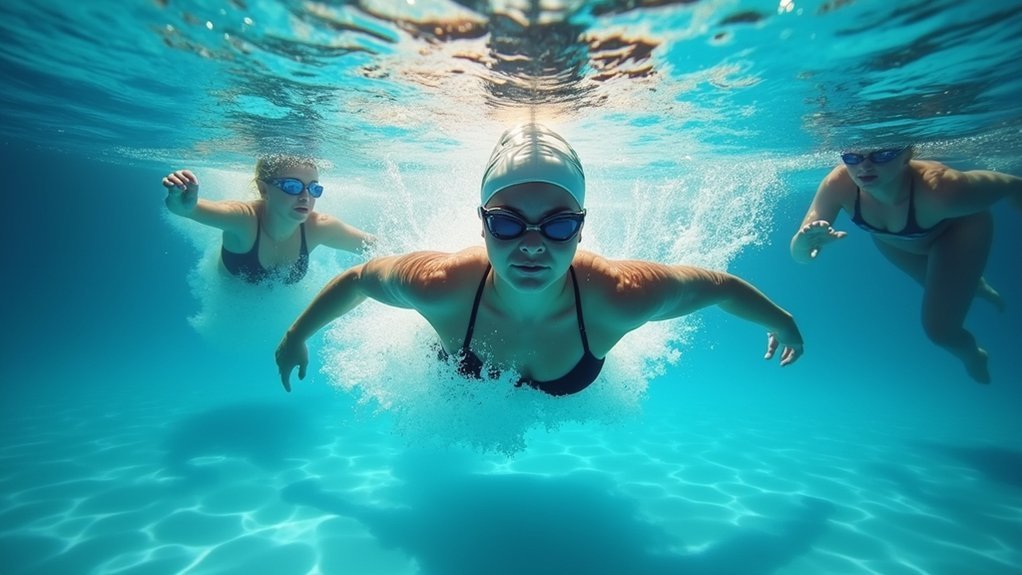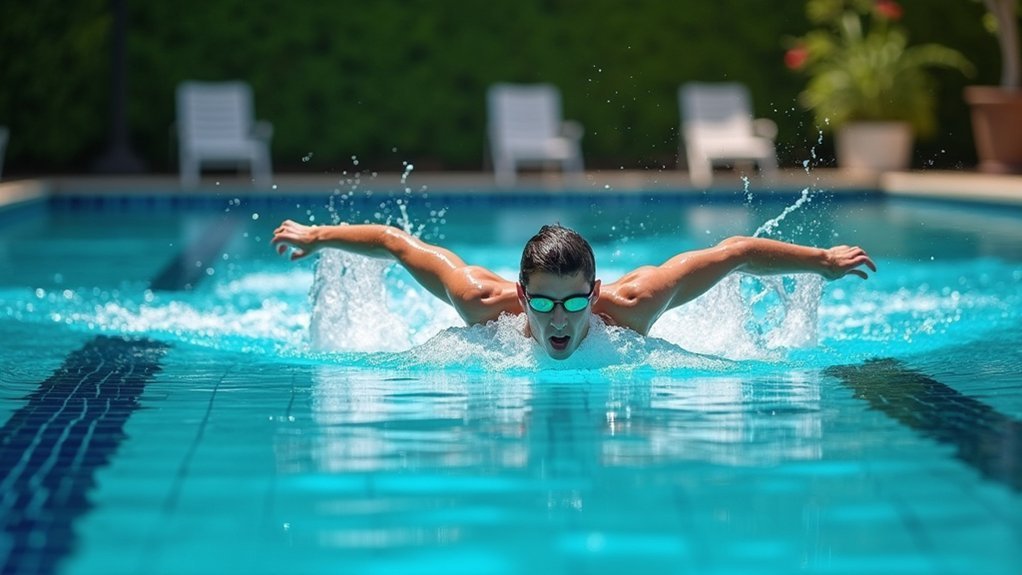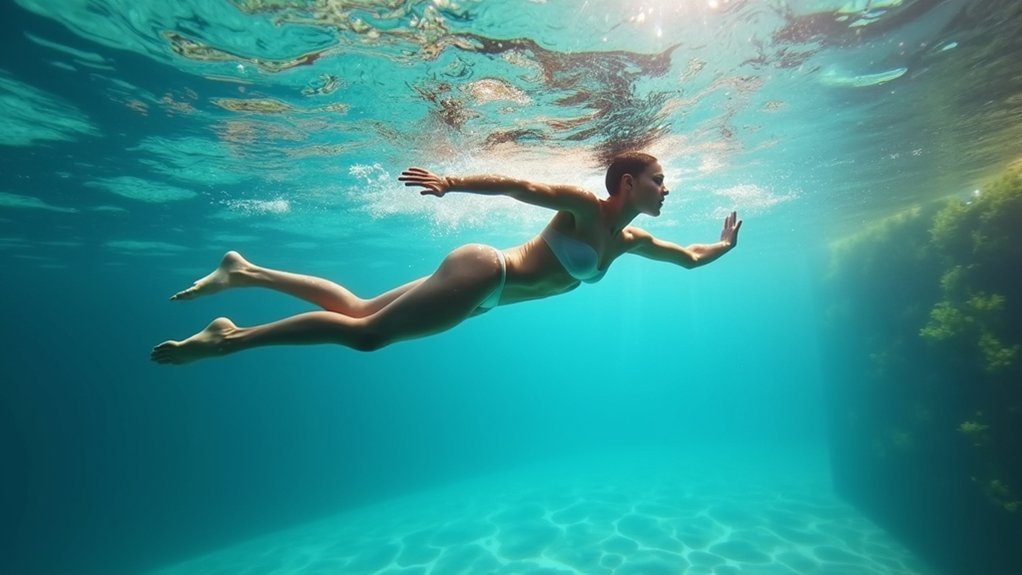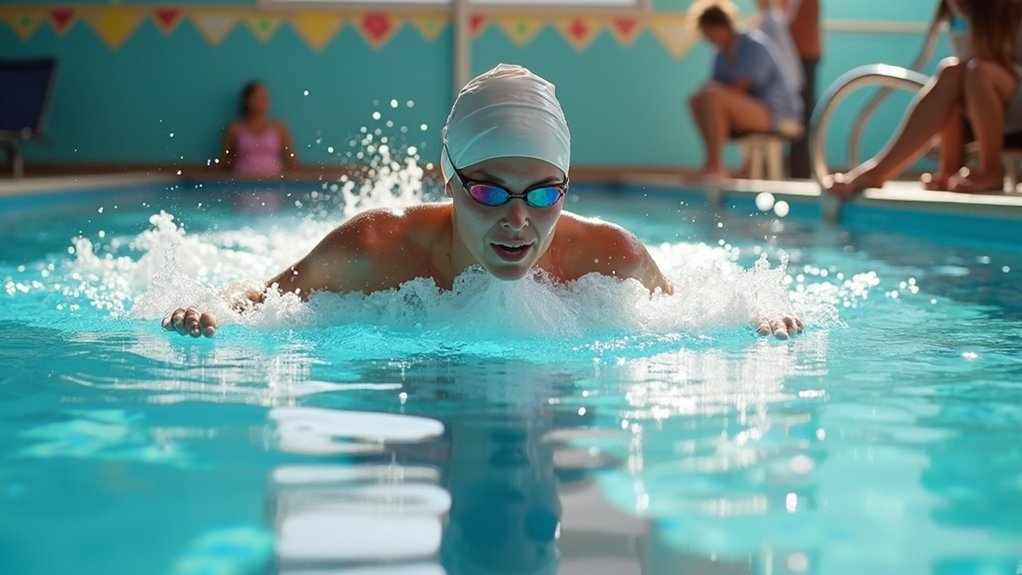Swimming offers seven powerful benefits for stroke recovery: reduced joint pressure through buoyancy, enhanced balance in a safe environment, improved muscle strength from water resistance, boosted cardiovascular fitness without high impact, psychological well-being, increased range of motion, and transferable skills for daily mobility. You’ll gain confidence as your body strengthens in water’s supportive embrace while minimizing fall risks. These advantages work together to create a thorough recovery approach that extends far beyond the pool.
Water’s Buoyancy Reduces Joint Pressure During Recovery

When recovering from a stroke, one of the most significant advantages of swimming comes from water’s natural buoyancy. This buoyant force counteracts gravity, reducing your apparent body weight and decreasing pressure on your joints as you move.
In chest-high water, hip and knee joint forces can be reduced by 58% and 62% respectively compared to land exercises. That’s over 100% of your body weight in absolute reduction! This reduced pressure allows you to perform movements that might be impossible or painful on land.
As you exercise in water, your joints receive support while still benefiting from the resistance that strengthens muscles. This combination creates an ideal environment for rehabilitation, letting you rebuild strength and mobility without the risk of overuse injuries common in land-based recovery programs. The enhanced recovery experienced by stroke patients is largely due to this buoyancy reducing their risk of falls during exercise.
Enhanced Balance Training in a Safe Aquatic Environment
Water’s natural buoyancy creates a safe environment where you’ll practice balance with minimal fall risk during stroke recovery.
You can relearn stability techniques while feeling supported, which isn’t always possible with land-based therapy.
The aquatic setting allows you to work on multidirectional movements that challenge and improve your balance skills without the anxiety of falling. Research confirms these exercises significantly improve Berg Balance Scale scores for stroke patients, demonstrating measurable progress in stability and function.
Reduced Fall Risk
For stroke survivors, one of the most significant advantages of aquatic therapy lies in its remarkable ability to reduce fall risk.
The supportive nature of water creates a secure environment where you can overcome your fear of falling while rebuilding essential movement skills.
Water’s natural resistance enhances proprioceptive training, improving your movement control and balance without the dangers associated with land-based exercises.
You’ll gain confidence as you safely practice balance exercises that would be risky on land.
Underwater treadmill exercises specifically target gait improvement—a vital factor in preventing falls.
Physical therapists can design individualized exercise programs that address your specific post-stroke impairments while maximizing safety and effectiveness.
As you master movements in the pool, you’ll build both physical capability and psychological confidence that transfers to land-based activities.
This progressive approach allows you to challenge yourself while remaining protected from fall injuries.
Buoyancy Supports Relearning
Buoyancy fundamentally transforms the rehabilitation landscape for stroke survivors by creating an ideal environment where relearning movement becomes possible before full strength returns.
Water reduces your body weight by up to 90%, dramatically decreasing joint stress while improving range of motion.
You’ll experience enhanced mobility in water as you practice movements that might be impossible on land. The warm aquatic environment relaxes muscles, reducing spasticity and pain that often limit traditional therapy.
Your therapist can customize exercises using methods like Halliwick or Proprioceptive Neuromuscular Facilitation tailored to your specific needs. Research consistently demonstrates strong evidence supporting improvements in lower extremity muscle strength during the subacute recovery phase.
As you exercise in water, you’ll gain confidence through the immediate proprioceptive feedback. Core muscles engage naturally to maintain stability, developing essential balance skills that transfer to everyday activities, helping you regain independence faster.
Multidirectional Stability Practice
While regaining your balance after a stroke presents considerable challenges, swimming provides an ideal environment for multidirectional stability training. Water’s buoyancy creates a safe space where you can practice various movements without fear of falling, considerably reducing injury risk.
In the pool, you’ll experience enhanced core engagement as water resistance naturally activates your stabilizing muscles. This multidirectional training improves your body’s ability to respond to different physical challenges, addressing muscle imbalances common after stroke. The water environment necessitates active stability through continuous muscle engagement, helping rebuild neurological pathways affected by the stroke.
Research confirms that aquatic exercises lead to measurable improvements in balance parameters and postural stability. The hydrostatic pressure supports better circulation while reducing joint strain, allowing pain-free movement.
Many stroke survivors find these aquatic-based improvements transfer effectively to land activities, accelerating their rehabilitation journey and restoring functional independence.
Improved Muscle Strength Through Natural Water Resistance
When stroke survivors enter the water for rehabilitation, they’re immediately embraced by one of nature’s most effective resistance training environments.
Water’s density—about 800 times greater than air—creates natural resistance that strengthens muscles without heavy weights.
You’ll experience resistance that adjusts automatically to your movement speed and strength level. This adaptive quality engages your muscles through both concentric and eccentric contractions, building strength while protecting your joints from impact.
The hydrostatic pressure supports your body, stabilizing joints and improving blood flow to aid recovery.
As you progress, you can easily modify intensity by changing your movement speed or adding equipment like paddles.
This natural resistance training stimulates muscle protein synthesis and helps prevent age-related muscle loss, making swimming an ideal rehabilitation option after stroke. Consistent water therapy also enhances recovery and stability, which is crucial for stroke survivors regaining their mobility and independence.
Boosted Cardiovascular Fitness With Low-Impact Exercise

Cardiovascular health represents another vital dimension of swimming’s rehabilitation power for stroke survivors.
When you enter the water, you’ll experience a unique environment where you can achieve higher exercise intensity with minimal impact on your body. The hydrostatic pressure supports blood flow back to your heart, reducing cardiovascular stress while you work out.
Research confirms the effectiveness of aquatic therapy, showing a remarkable 22% increase in VO2max through water-based programs—often outperforming land exercises.
You’ll appreciate how swimming reduces your risk of secondary cardiovascular events while building exercise tolerance in a comfortable, fall-free environment.
The warm water relaxes your muscles and improves circulation, creating ideal conditions for recovery.
With proper supervision and safety measures, you’ll find hydrotherapy both accessible and effective for your long-term rehabilitation journey.
Psychological Benefits of Swimming After Stroke
Beyond the physical rehabilitation benefits, swimming offers profound psychological advantages for stroke survivors.
When you immerse yourself in water, your brain receives increased blood flow, enhancing cognitive function and supporting neuroplasticity—crucial for rewiring your brain after stroke.
The warm water naturally relaxes your muscles, reducing spasticity while boosting your endorphin production. You’ll likely experience decreased anxiety and improved mood with each session.
The buoyancy provides a sense of freedom and confidence in movement that’s often lost after stroke.
Swimming also creates opportunities for social connection through group classes, helping combat isolation.
The rhythmic nature of swimming promotes mindfulness, creating a calming effect that improves your emotional stability.
Research shows swimming therapy leads to measurable improvements in emotional status and overall psychological well-being.
Regular aquatic therapy ultimately enhances your quality of life, independence, and overall mental well-being.
Greater Range of Motion and Flexibility in Water

Water’s remarkable buoyancy transforms range of motion possibilities for stroke survivors, enabling movements that might seem impossible on land. You’ll experience up to 90% reduced body weight in water, allowing you to move joints fully without pain or fear of falling.
Warm water relaxes your muscles and reduces spasticity, creating ideal conditions for flexibility improvements that surpass land-based therapy results. The viscosity of water provides natural resistance that helps strengthen muscles while you work on improving flexibility.
| Water Exercise Benefits | Land Exercise Limitations | Impact on Recovery |
|---|---|---|
| Supports full joint motion | Limited by gravity | Faster progress |
| Reduces fall risk | Higher injury potential | Greater confidence |
| Decreases joint stress | Weight-bearing strain | Less pain |
| Enhances muscle relaxation | Muscle tension common | Reduced spasticity |
| Allows challenging movements | Restricted movements | Improved independence |
You’ll find stretching more effective and comfortable in water, while the hydrostatic pressure improves blood circulation to enhance your overall flexibility gains.
Transitioning Aquatic Skills to Everyday Mobility
You’ll find that movement patterns mastered in water can directly transfer to your everyday activities at home.
The buoyancy-supported techniques you’ve practiced in the pool build fundamental strength and coordination that improve your ability to navigate real-world environments.
As you progress in your recovery, these aquatic skills will gradually build your confidence for land-based movements, making daily tasks like walking, reaching, and balancing considerably more manageable. Aquatic therapy creates a safe environment for practicing balance exercises that translate into better stability when performing routine activities.
From Pool to Home
Once stroke survivors experience mobility improvements in the water, the challenge becomes transferring these gains to everyday life. The skills you develop during aquatic therapy can greatly enhance your ability to perform daily activities independently.
- Daily routine integration allows you to apply water-based exercises to tasks like climbing stairs or moving between sitting and standing positions.
- Increased confidence from improved mobility and balance makes everyday movements less intimidating.
- Fall risk reduction occurs naturally as your coordination and stability improve through consistent practice.
- Functional activities like walking become easier as your aquatic therapy strengthens the same muscle groups needed on land.
With home-based equipment like swim spas or underwater treadmills, you can continue your recovery journey in a comfortable, accessible environment at your own pace. The low-impact nature of swimming makes it particularly beneficial for stroke patients who may struggle with more strenuous forms of rehabilitation.
Transferable Movement Patterns
The movements you master during aquatic therapy directly translate to improved function on dry land, creating neural pathways that enhance your everyday mobility.
Swimming engages the same muscles—deltoids, supraspinatus, and serratus anterior—that you use in daily activities.
Your scapular stabilizers, strengthened during swim sessions, improve posture and reduce scapular winging when you’re walking or reaching.
The core strength you develop supports better balance and posture in all activities.
Water’s natural resistance trains your muscles more effectively than many land exercises, building endurance that transfers to prolonged daily tasks.
You’ll notice improvements in joint mobility and flexibility as you recover, with cardiovascular benefits extending to all physical activities.
The continuous nature of backstroke kicking helps develop sustained muscle engagement without the recovery phase that exists in arm movements, promoting endurance in lower body function.
These transferable patterns help stroke patients restore gait and reduce fall risk, making everyday movements more natural and confident.
Land-Based Confidence Building
Shifting from the supportive buoyancy of water to solid ground represents a significant phase in stroke recovery, requiring both physical adaptation and psychological readiness.
You’ll need specific strategies to successfully convert aquatic skills to everyday mobility.
To build confidence for land-based activities:
- Use conversion tools like walking aids initially to provide support while you adapt movement patterns learned in water
- Practice positive self-talk and visualization techniques to combat decreased self-esteem common after stroke
- Join community support groups where shared experiences strengthen your psychological resilience
- Set achievable, personalized goals that acknowledge your individual recovery journey
The mental component is just as vital as physical training. Dedicating twenty minutes daily to journaling about your recovery progress can significantly reduce stress levels and provide clarity during this transition.
Your aquatic therapy success creates a foundation of confidence that, with proper techniques and support, will translate into improved mobility on land.
Frequently Asked Questions
When Is It Safe to Begin Aquatic Therapy After Stroke?
You can begin aquatic therapy after stroke when you’ve received medical clearance, typically within days or weeks post-stroke. You’ll need professional supervision, appropriate pool conditions, and consideration of your recovery stage.
Can Non-Swimmers Participate in Aquatic Stroke Rehabilitation?
Yes, you don’t need swimming skills to participate in aquatic stroke rehabilitation. You’ll work in shallow water with support from therapists, using the water’s buoyancy to safely perform exercises that aid your recovery.
How Does Chlorine Affect Post-Stroke Skin Sensitivity?
After a stroke, your skin may be more sensitive to chlorine. It can cause dryness, irritation, and worsen existing skin conditions. You’ll need extra moisturizing and should consider shorter swim sessions to protect your skin.
Are There Insurance Coverage Options for Aquatic Stroke Therapy?
Medicare Part B covers your aquatic stroke therapy when it’s medically necessary. You’ll need documentation from your healthcare provider. Medicaid and private insurance may also cover it, but you’ll need to verify specific coverage details.
How Often Should Aquatic Therapy Sessions Occur for Optimal Recovery?
For ideal recovery, you’ll typically benefit from attending aquatic therapy sessions 2-3 times per week. Your therapist will customize this frequency based on your specific condition and how you’re responding to treatment.
In Summary
You’ve discovered seven remarkable swimming benefits that can transform your stroke recovery journey. Water’s unique properties provide the perfect environment to rebuild strength, balance, and confidence while protecting your healing body. As you continue swimming, you’ll likely notice improvements extending beyond the pool into your daily activities. Embrace this therapeutic approach as a powerful ally in reclaiming your independence and mobility after stroke.





Leave a Reply